|
|
|
Sort Order |
|
|
|
Items / Page
|
|
|
|
|
|
|
| Srl | Item |
| 1 |
ID:
178601
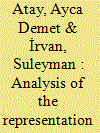

|
|
|
|
|
| Summary/Abstract |
This study assesses the representation of the so-called ‘Solution Process’ between the Turkish state and the insurgent armed organization Kurdistan Workers’ Party within the theoretical frameworks of peace journalism, indexing hypothesis, and Hallin and Mancini's media systems theory. The research comprises a frame analysis of the front page coverage of the ‘Solution Process’ in eleven Turkish newspapers in 2013, which is conducted on a total of 561 news stories. The results show that the Turkish press, with the exception of nationalist newspapers, supported the peace process in the selected time period. However, this peace-supportive approach cannot be attributed to peace journalism because the pro-peace attitude of the news media did not result from an independent journalistic initiative. Therefore, we refer to this type of journalism as ‘state-imposed peace journalism’.
|
|
|
|
|
|
|
|
|
|
|
|
|
|
|
|
| 2 |
ID:
144081
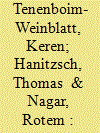

|
|
|
|
|
| Summary/Abstract |
This article presents a general framework for deconstructing and classifying conflict news narratives. This framework, based on a nuanced and contextual approach to analyzing media representations of conflict actors and events, addresses some of the weaknesses of existing classification schemes, focusing in particular on the dualistic approach of the peace journalism model. Using quantitative content analysis, the proposed framework is then applied to the journalistic coverage in the Israeli media of three Middle-Eastern conflicts: the Israeli–Palestinian conflict, the conflict surrounding Iran's nuclear program, and the Syrian civil war. The coverage is examined in three leading news outlets – Haaretz, Israel Hayom, and Ynet – over a six-month period. Based on hierarchical cluster analysis, the article identifies four characteristic types of narratives in the examined coverage. These include two journalistic narratives of violence: one inward-looking, ethnocentric narrative, and one outward-looking narrative focusing on outgroup actors and victims; and two political-diplomatic narratives: one interactional, and one outward-looking. In addition to highlighting different constellations of points of view and conflict measures in news stories, the identified clusters also challenge several assumptions underlying existing models, such as the postulated alignment between elite/official actors and violence frames
|
|
|
|
|
|
|
|
|
|
|
|
|
|
|
|
| 3 |
ID:
193201
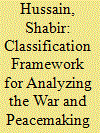

|
|
|
|
|
| Summary/Abstract |
In this study, we present a contextual model for analyzing the escalatory and de-escalatory trends in media reporting of seven conflicts in Pakistan. For this purpose, we combined findings from both survey and content analysis. While the survey helped to examine the journalists’ perceptions about the security threats of conflicts and the factors that influence the reportage, the content analysis was utilized to analyze the escalatory and de-escalatory characteristics in the coverage. The findings show that high security conflicts lead to a patriotic reporting scenario that results in high escalatory coverage. There is a significant decrease in the escalatory coverage as the assumed threat level of a conflict decreases. Similarly, we found that a conflict in which journalists exercised more relative freedom from pressure groups was reported in de-escalatory fashion. These findings can be useful for strategizing for the implementation of peace journalism in Pakistan in particular and elsewhere in general.
|
|
|
|
|
|
|
|
|
|
|
|
|
|
|
|
| 4 |
ID:
146922
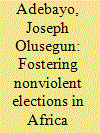

|
|
|
|
|
| Summary/Abstract |
Given that most Africans view political aspirants in terms of their ethnic and religious lineage rather than political ideology, and since most Africans rely on the media for information, there is a tendency to fall prey to biased and insensitive reportage, capable of inciting violence elicited by the prejudiced information often presented as news, features, commentaries, documentaries, etc. This article hypothesises that with appropriate training on conflict-sensitive reportage, journalists can foster peaceful and nonviolent elections through their reportage. The article recommends the adoption of an alternative method of news reportage using the peace-journalism model. The model, developed by Jake Lynch and Annabel McGoldrick, encourages journalists to report social issues in ways that create opportunities for a society to consider and value nonviolent responses toward conflict by using the insights from conflict analysis and transformation to update concepts of balance, fairness and accuracy in reporting. It also provides a new route map that traces the connections between journalists, their sources, the stories they cover and the consequences of their reportage. In addition, it builds awareness of nonviolence and brings creativity into the practical job of everyday editing and reporting. This article holds theoretical significance in that it explicitly identifies conditions that encourage journalists to apply conflict sensitivity to their reportage, thereby promoting societal peace, particularly during elections.
|
|
|
|
|
|
|
|
|
|
|
|
|
|
|
|
| 5 |
ID:
121992


|
|
|
| 6 |
ID:
085715


|
|
|
|
|
| Publication |
2008.
|
| Summary/Abstract |
The field of media development, as an intervention in conflict-affected societies, is both growing, and divided. This article identifies and discusses some emerging divisions in the sub-field of journalist training. On the one hand is a 'modernisation' approach, geared towards the implantation of western-style precepts and methods for reporting conflicts. On the other is a critical pedagogical approach intended to enable participatory media development. In the latter, 'minority world journalism' is effectively problematised, especially around assumptions about the role of the journalist vis-a--vis conflict and whether it is proper, permissible and/or practically possible for editors and reporters to set out to contribute to peace. The contestation this divide has occasioned partly recapitulates the UNESCO media debate of the late 1970s and early 1980s. The concept of peace journalism is now attracting attention, both as a form of critical pedagogy in journalist training and as a potential rallying point for reviving calls for structural reform in the world information and communication
|
|
|
|
|
|
|
|
|
|
|
|
|
|
|
|
| 7 |
ID:
171968
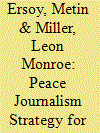

|
|
|
|
|
| Summary/Abstract |
This article describes a peace journalism model for conflict resolution based on collaboration within a public forum established by using alternative media. In other words, peace journalists have initiated a new type of public sphere that helps to overcome the inadequacies of the liberal peace agenda. The article proposes that reconciliation is enhanced by shifting the emphasis to collaborative engagement in order to create shared values and common principles. The unique contribution of this study is expanding Galtung’s peace journalism approach to conflict resolution to include using communication media to create a public sphere that establishes shared values. Thus, the article presents a viable dialogic and dialectic model for conflict resolution in Cyprus with its peace journalism response to criticisms regarding the role of the Cypriot press. Consequently, the developed model establishes an example for the regions in the world where ethnic conflicts are experienced.
|
|
|
|
|
|
|
|
|
|
|
|
|
|
|
|
| 8 |
ID:
123309
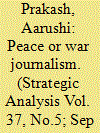

|
|
|
|
|
| Publication |
2013.
|
| Summary/Abstract |
Analysing peace journalism is a difficult task, especially within the context of an ongoing conflict. This study looks at peace journalism as it relates to the Balochistan/Pakistan conflict. Balochistan is a Pakistani province that makes up a large part of the country and is rich in natural resources. The Pakistani government has employed a policy of resource exploitation in the province, withholding any due share of profit from the Baloch. The conflict, which has been ongoing since the partition of India, has increasingly become a subject of debate in both the Pakistani and the international media, especially since the US Congress passed a non-binding resolution in favour of Balochistan's right to self-determination. This research study examines the extent of peace journalism in both the traditional and social media in Pakistan since the congressional resolution. The content analysis uses a sample of 100 articles drawn from four Pakistani newspapers, as well as 1,000 tweets from various relevant Twitter users. Using models derived from Galtung and built upon by Lynch and McGoldrick, this study reflects an apparent display of peace journalism in the working timeframe from various different sources.
|
|
|
|
|
|
|
|
|
|
|
|
|
|
|
|
|
|
|
|
|